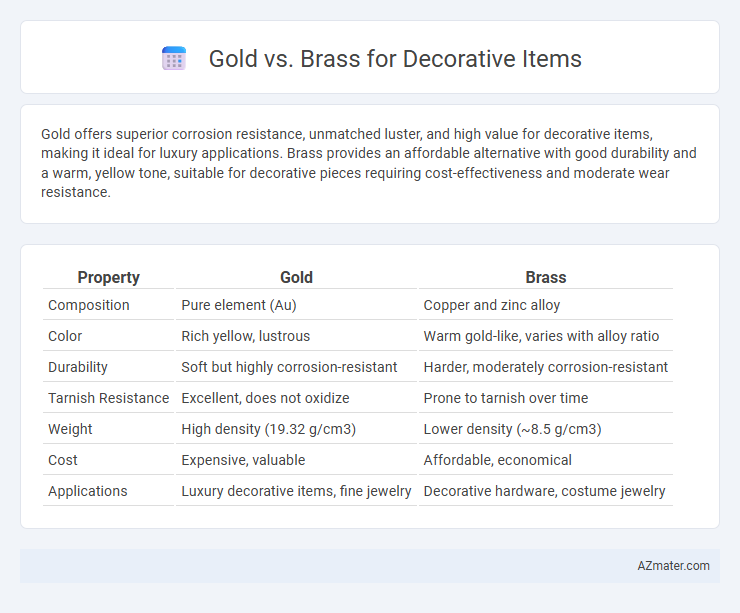Gold offers superior corrosion resistance, unmatched luster, and high value for decorative items, making it ideal for luxury applications. Brass provides an affordable alternative with good durability and a warm, yellow tone, suitable for decorative pieces requiring cost-effectiveness and moderate wear resistance.
Table of Comparison
| Property | Gold | Brass |
|---|---|---|
| Composition | Pure element (Au) | Copper and zinc alloy |
| Color | Rich yellow, lustrous | Warm gold-like, varies with alloy ratio |
| Durability | Soft but highly corrosion-resistant | Harder, moderately corrosion-resistant |
| Tarnish Resistance | Excellent, does not oxidize | Prone to tarnish over time |
| Weight | High density (19.32 g/cm3) | Lower density (~8.5 g/cm3) |
| Cost | Expensive, valuable | Affordable, economical |
| Applications | Luxury decorative items, fine jewelry | Decorative hardware, costume jewelry |
Introduction: Gold vs Brass for Decorative Items
Gold offers unmatched luster, durability, and resistance to tarnish, making it a premium choice for decorative items that retain value over time. Brass, an alloy of copper and zinc, provides an affordable, versatile alternative with a warm golden hue that can be polished to shine or left to develop a natural patina. Choosing between gold and brass depends on budget, desired aesthetic, and the item's intended longevity and maintenance requirements.
Material Composition: Comparing Gold and Brass
Gold consists primarily of pure gold (Au), a dense, malleable metal with high resistance to corrosion and tarnish, enhancing its longevity and premium appeal in decorative items. Brass is an alloy mainly composed of copper (Cu) and zinc (Zn), often blended in varying ratios to achieve desired strength and color, making it more affordable but prone to tarnishing over time. The inherent material properties of gold contribute to its higher value and durability, whereas brass offers versatility and cost-effectiveness for decorative applications.
Visual Appeal: Color, Shine, and Texture Differences
Gold offers a rich, warm yellow hue with a natural, deep luster that enhances luxury and elegance, while brass displays a brighter, more golden-yellow tone with subtle reddish undertones that create a vintage or rustic charm. Gold's smooth texture and consistent shine maintain a high-end, polished appearance over time, contrasted by brass's slightly grainy surface and propensity to develop an attractive patina that adds character. The color stability and radiant glow of gold make it ideal for opulent decorative items, whereas brass's varied shine and textured finish provide a versatile, timeless aesthetic.
Durability and Longevity
Gold offers superior resistance to tarnish and corrosion, ensuring long-lasting luster and minimal maintenance for decorative items. Brass, while more affordable, is prone to oxidation and requires regular polishing to maintain its appearance. For durability and longevity, gold remains the preferred choice due to its inherent corrosion resistance and enduring aesthetic appeal.
Cost Analysis: Affordability and Value
Brass offers a significantly lower cost compared to gold, making it a more affordable option for decorative items while still providing an attractive appearance. Gold's high price is driven by its rarity and intrinsic value, which also contributes to greater long-term investment potential. Choosing brass maximizes budget efficiency, whereas gold enhances value and prestige in decorative pieces.
Maintenance and Care Requirements
Gold decorative items require minimal maintenance due to their resistance to tarnish and corrosion, making them ideal for long-term display. Brass items demand regular polishing and protective coatings to prevent oxidation and maintain their shine. Proper care extends the lifespan of both materials, but gold's natural durability reduces the frequency of upkeep compared to brass.
Tarnish and Corrosion Resistance
Gold exhibits exceptional tarnish and corrosion resistance due to its inert chemical properties, making it ideal for long-lasting decorative items that maintain their luster over time. Brass, an alloy of copper and zinc, is more prone to tarnishing and developing a patina when exposed to air and moisture, requiring regular maintenance to preserve its shine. For decorative applications demanding durability and minimal upkeep, gold remains the superior choice despite its higher cost compared to brass.
Versatility in Design and Craftsmanship
Gold offers exceptional malleability and luster, enabling intricate designs and high-end craftsmanship ideal for luxurious decorative items. Brass provides greater versatility in design due to its affordability, durability, and ability to mimic gold's appearance, making it popular for a wide range of decorative applications. Artisans leverage brass's ease of casting and engraving to create detailed, durable pieces that combine aesthetic appeal with cost-effective production.
Popular Decorative Applications: Gold vs Brass
Gold is highly favored in luxury decorative applications such as jewelry, high-end clocks, and ornate picture frames due to its unmatched luster, corrosion resistance, and prestige. Brass, known for its warm golden hue and affordability, is popular in decorative hardware, musical instruments, and vintage-style lighting fixtures, offering durability with an antique aesthetic. Both materials are valued for distinct decorative uses, with gold emphasizing elegance and status, while brass provides versatility and classic charm.
Environmental Impact and Sustainability
Gold mining generates significant environmental damage, including habitat destruction, toxic chemical use, and high energy consumption, making it less sustainable for decorative items. Brass, composed primarily of copper and zinc, is more eco-friendly due to its recyclability and lower environmental footprint during production. Consumers seeking sustainable decor prefer brass for its durability, recyclability, and reduced reliance on environmentally harmful mining practices.

Infographic: Gold vs Brass for Decorative Item
 azmater.com
azmater.com